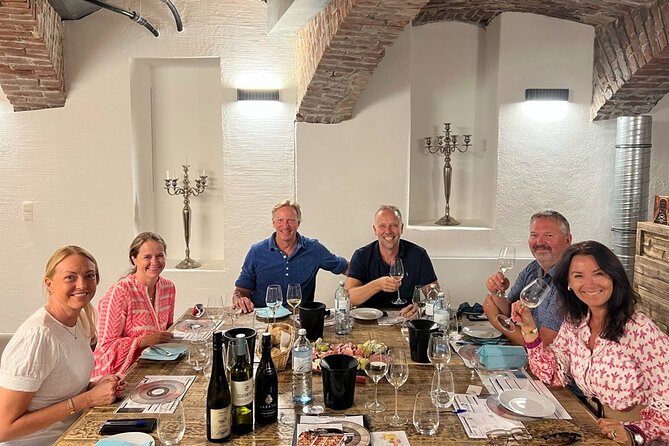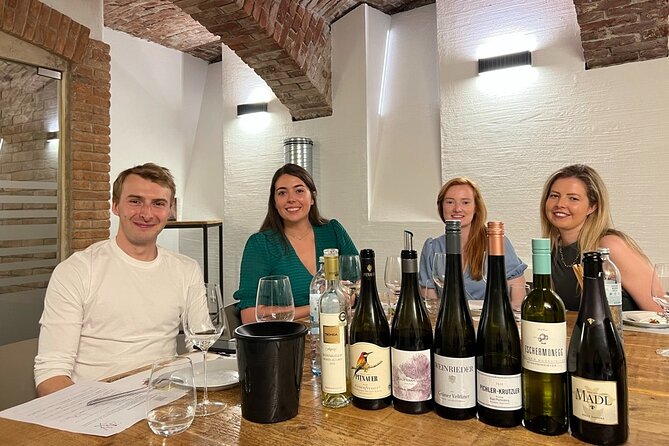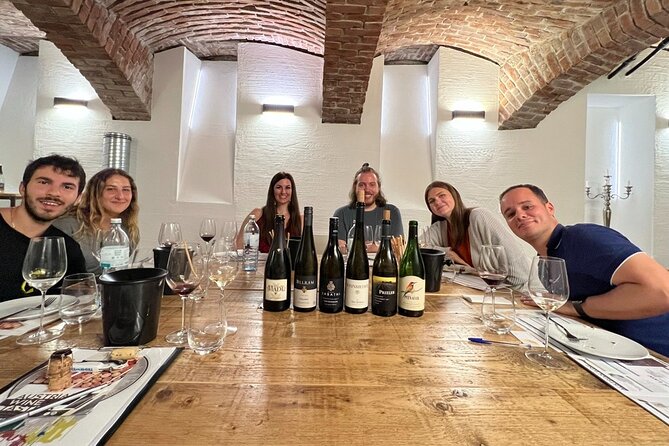Austria’s wine landscape is a diverse tapestry of rich history, innovative winemaking, and a unique terroir that sets it apart. From the crisp whites of Niederösterreich to the bold reds of Burgenland, each region contributes its own captivating character to the country’s thriving wine scene. Signature grape varieties like Grüner Veltliner and Blaufränkisch showcase Austria’s prowess, blending time-honored traditions with modern techniques. Explore this captivating world, and you’ll uncover a wealth of flavors and stories waiting to be explored.
This experience made our list of the 20 Best Wine Tours In Vienna.
Key Points

• Austria is home to diverse wine regions, each with its own distinct terroir and grape varieties, contributing to the country’s thriving wine scene.
• Grüner Veltliner, Riesling, Blaufränkisch, and Zweigelt are some of Austria’s signature grape varieties known for their exceptional quality.
• Austrian wineries employ sustainable and innovative winemaking practices, blending time-tested traditions with modern techniques to produce high-quality, distinct wines.
• The country’s notable wine styles include crisp and aromatic whites, elegant and age-worthy reds, as well as vibrant and food-friendly wines with pronounced minerality.
• Austria’s winemaking heritage dates back to the Roman era, and the industry has continually evolved, adapting to consumer tastes and cementing the country’s status as a leading force in global wine production.
Austrian Wine Regions

Austrian Wine Regions
Austria’s wine regions stretch across the country, each with its own unique terroir and grape varieties. From the rolling hills of Niederösterreich in the north to the sun-drenched vineyards of Burgenland in the east, Austria’s diverse wine landscape offers a wealth of flavors and styles for wine enthusiasts to explore.
In the north, Niederösterreich is the largest wine-growing region, known for its crisp, fresh white wines made from grapes like Grüner Veltliner and Riesling.
Further south, Steiermark boasts a cooler climate that produces elegant, aromatic whites.
Meanwhile, Burgenland in the east is renowned for its rich, full-bodied reds from varieties like Blaufränkisch and Zweigelt.
Each region brings its own unique character to Austria’s thriving wine scene.
You can also read our reviews of more wine tours in Vienna
Grape Varieties in Austria

While Austria’s wine regions are diverse, the country’s grape varieties are similarly varied and distinctive. Grüner Veltliner, the country’s signature white grape, produces crisp, aromatic wines with notes of white pepper and citrus. Riesling, another renowned Austrian white, thrives in the cooler northern regions and yields racy, mineral-driven styles. In the red wine realm, Blaufränkisch and Zweigelt are two of Austria’s most celebrated grape varieties, contributing lush, full-bodied reds with vibrant acidity and complex flavors.
| Grape Variety | Key Characteristics |
|---|---|
| Grüner Veltliner | Crisp, Aromatic, White Pepper, Citrus |
| Riesling | Racy, Mineral-driven |
| Blaufränkisch | Lush, Full-bodied, Vibrant Acidity |
| Zweigelt | Lush, Full-bodied, Complex Flavors |
Winemaking Traditions in Austria

Though deeply rooted in tradition, Austrian winemakers have deftly embraced modern techniques, blending time-honored practices with innovative approaches to crafting world-class wines.
Generations-old family wineries utilize sustainable methods, employing biodynamic and organic farming to nurture their vineyards. They carefully monitor fermentation, regulate temperature, and meticulously age their wines to coax out the most nuanced flavors.
Yet, they’re not afraid to experiment – some wineries have even incorporated cutting-edge technologies like temperature-controlled stainless steel tanks and state-of-the-art filtration systems.
This dynamic balance between time-tested tradition and progressive innovation has contributed to Austria’s growing reputation as a premier wine-producing region, delighting oenophiles around the world.
Notable Austrian Wine Styles

From crisp, aromatic whites to bold, complex reds, Austria’s wine portfolio showcases an array of distinctive styles that have captivated wine enthusiasts worldwide.
Austria’s signature white grape varieties, like Grüner Veltliner and Riesling, produce vibrant, food-friendly wines with pronounced minerality and citrus notes.
On the red side, the country’s winemakers excel with varietals like Blaufränkisch and St. Laurent, crafting elegant, age-worthy reds that exhibit deep color, firm tannins, and layers of black fruit and spice.
Whether you’re exploring the delicate, floral Wachau wines or the powerful, structured reds of Burgenland, Austria’s remarkable diversity of wine styles offers something to delight every palate.
History of Austrian Viticulture

Austria’s winemaking heritage dates back centuries, with viticulture firmly rooted in the country’s cultural and agricultural identity. The first records of Austrian wine production can be traced to the Roman era, when the region’s ideal climate and fertile soil were recognized for their grape-growing potential.
Over the centuries, Austria’s winegrowers have refined their techniques, adapting to changes in consumer tastes and market demands. Today, the country’s winemakers continue to uphold traditional methods while embracing innovative approaches, producing a diverse range of high-quality wines that showcase the unique terroirs of Austria’s renowned wine regions.
This rich history and ongoing commitment to excellence have cemented Austria’s status as a leading force in the global wine industry.
Terroir and Climate Influence

What makes Austrian wine so distinct is the profound influence of the country’s unique terroir and climate.
From the cool, continental climate of the Wachau region to the warmer, drier conditions of Burgenland, Austria’s diverse geographical features and microclimates play a crucial role in shaping the character and quality of its wines.
The Alps in the west create a rain shadow effect, leading to lower precipitation and more sunshine in the east. Soils too, ranging from loess to limestone, and even volcanic origins, contribute to the complexity and minerality found in Austrian vintages.
This interplay of natural factors results in a remarkable array of wine styles, from crisp, aromatic whites to structured, age-worthy reds.
Food Pairing With Austrian Wines

Austrian wines pair exceptionally well with a variety of foods, showcasing the incredible versatility of the country’s diverse wine styles. Their balance of acidity, fruit, and structure make them excellent companions to an array of cuisines, from hearty Central European dishes to lighter, Mediterranean-inspired fare.
Crisp, mineral-driven white wines like Grüner Veltliner and Riesling are perfect foils for dishes featuring fresh seafood, salads, and delicate preparations.
Meanwhile, the fuller-bodied red wines, such as Blaufränkisch and St. Laurent, shine when paired with roasted meats, stews, and dishes with bold, umami-rich flavors.
Whether you’re enjoying a traditional Viennese Schnitzel or a vibrant vegetarian meal, there’s an Austrian wine ready to complement and enhance the flavors.
Emerging Trends in Austrian Wines

While Austrian wines have long been celebrated for their exceptional food pairing abilities, the country’s wine industry is also evolving with a range of emerging trends that are capturing the attention of oenophiles worldwide.
One notable development is the growing popularity of indigenous grape varieties, such as Grüner Veltliner and Blaufränkisch, which are showcasing the unique terroir and character of Austrian viticulture.
Plus, there’s an increasing focus on sustainable and organic winemaking practices, with many producers embracing biodynamic methods to enhance the purity and authenticity of their wines.
On top of that, the rise of small, family-owned wineries is contributing to the diversity and dynamism of the Austrian wine scene, as these artisanal producers experiment with new styles and techniques.
Frequently Asked Questions
How Long Does It Take to Get to the Wine Tasting Location?
The wine tasting location is a 5-10 minute walk from the nearest public transportation. Guests can easily find the exclusive wine experiences venue at the given address in central Vienna.
Can I Bring My Own Food to the Wine Tasting?
No, participants can’t bring their own food to the wine tasting. The experience includes a locally-sourced food platter, so there’s no need to bring additional snacks. The focus is on enjoying the Austrian wines provided during the 1-hour 15-minute activity.
Is the Wine Tasting Suitable for Vegetarians/Vegans?
The wine tasting is suitable for vegetarians and vegans, as it includes a locally-sourced bread platter. Guests can enjoy the wines without any meat or animal products. The experience caters to dietary requirements, ensuring everyone can participate fully.
Can I Take the Wine Bottles Home After the Tasting?
Unfortunately, participants cannot take the wine bottles home after the tasting. The wines are provided for the in-person experience only. However, guests can purchase wine from the supplier if they wish to enjoy the Austrian vintages further.
Is It Possible to Extend the Duration of the Wine Tasting?
Yes, it’s possible to extend the duration of the wine tasting. Guests can inquire about extending the session when booking, and the provider may be able to accommodate a longer experience for an additional fee.
Recap
Austria’s wine industry continues to flourish, offering a diverse range of exceptional wines that capture the country’s rich viticultural heritage.
From the crisp whites of Niederösterreich to the bold reds of Burgenland, each region showcases its unique terroir and grape varieties.
As Austrian winemakers embrace tradition while driving innovation, the world is taking notice of this dynamic wine-producing powerhouse.
More Wine Tours in Vienna
More Tour Reviews in Vienna
- Vienna: Wine Tasting Tour with Local Delicacies
- Vienna: Madame Tussauds Admission Ticket
- Explore Bratislava with a Local: Private Tour from Vienna
- Private day trip from Vienna to Melk & Dürnstein in English
- Grand Historical and Cultural Vienna City Tour
- Private Day Trip to Hallstatt and Salzburg from Vienna
Not for you? Here's more nearby things to do in Vienna we have reviewed
- Vienna: Wine Tasting Tour with Local Delicacies
- Vienna: Madame Tussauds Admission Ticket
- Explore Bratislava with a Local: Private Tour from Vienna
- Private day trip from Vienna to Melk & Dürnstein in English
- Grand Historical and Cultural Vienna City Tour
- Private Day Trip to Hallstatt and Salzburg from Vienna
- Vienna: Private Walking Tour with a Local
- Vienna Spanish Riding School Guided Tour
- Vienna: Carriage Ride Through Schönbrunn Palace Gardens
- Vienna: Tour with Private Guide
- Vienna: Customizable Private Bike Tour
- Vienna: Leopold Museum Skip-the-Line Entry Ticket
